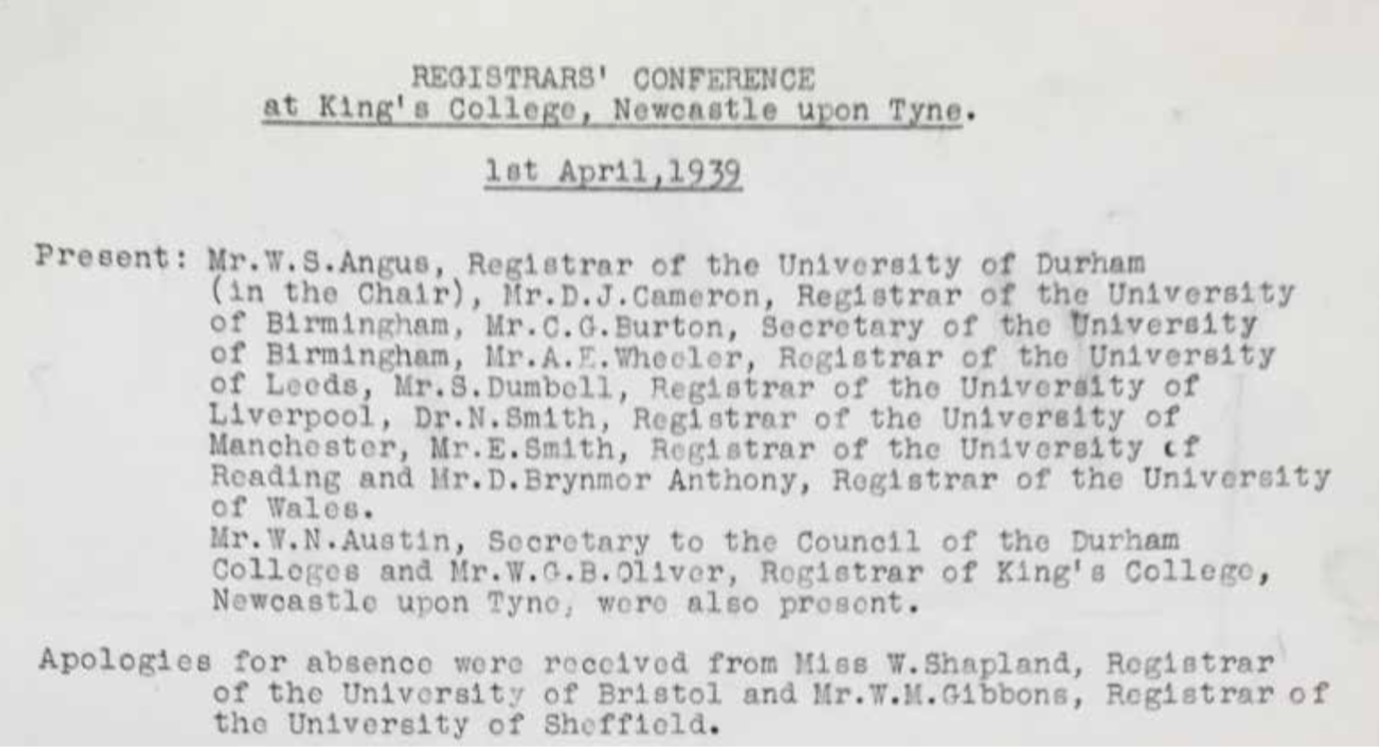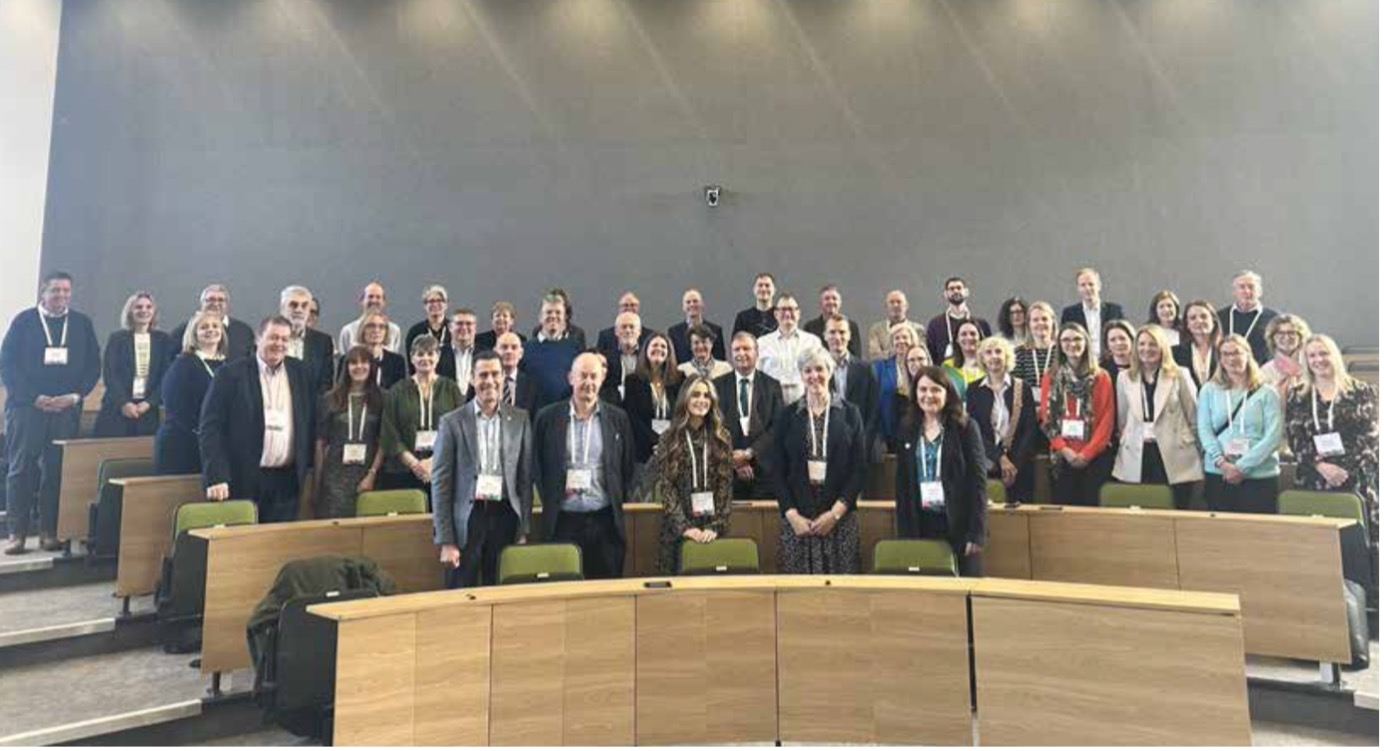Many will not have seen this rather wonderful short history of AHUA, the Association of Heads of University Administration, published in 2024 and written by John Hogan, who retired as registrar at Newcastle University in 2022.
Having been involved in AHUA for 18 years to the end of 2024, including 11 years on the executive and a couple of years as Honorary Secretary, I thought I had seen quite a lot in terms of the association’s development. However, as this report shows, I really did not know the half of it and my contributions were genuinely minor alongside the achievements of those who went before.
In development
The origins of what is now AHUA date back, in formal records at least, to a “Registrars’ Conference” in 1939, just before the outbreak of war. It was attended by ten people representing seven different universities (with apologies from two more) and chaired by the registrar of Durham University, William Angus (later secretary at the University of Aberdeen from 1952 to 1967 and referred to by his previous colleagues as “Aberdeen Angus,” apparently).

Extract from the minutes of the 1939 Registrars’ Conference
While some of the issues discussed were very much of the time, such as air raid precautions, others have contemporary resonance such as ensuring inclusion of students on the electoral register. Admittedly this was a slightly different situation given that there were university constituencies at that time and there were real concerns about institutions’ ability adequately to count potential electors. Other issues though seem very familiar including student health, international students, admissions qualifications and student fees.
As the organisation developed as the Conference of Registrars and Secretaries (CRS), after the war it became UK-wide and spent considerable time in the 1960s discussing and dealing with an expanded HE sector such that it had 23 UK universities in membership by then.
As noted in John Hogan’s report – and as is evident from the photographs from conferences in the 60s through to the early 90s – it was a hugely white male-dominated organisation for many years, reflective of university administrations at that time.
Fortunately, much has changed in composition since then. Structures in universities were rather different in those days too although for the whole membership, regardless of title, a core duty was acting as a confidential source of advice and support for the vice chancellor. Further elements identified in the 1960s which continue to be a part of many AHUA members’ roles include leading a significant portfolio of university services and advising the university’s statutory bodies and other senior officers. Relative to today numbers were tiny – only around 400 administrative staff in 1953 rising to a still modest figure of around 1,900 by 1973, although both of these numbers exclude what were deemed “clerical” posts.
It is also interesting to note that, under the auspices of the Committee of Vice-Chancellors and Principals (CVCP), a number of registrars were heavily involved in the establishment of the Universities Central Council on Admissions (UCCA) in 1961. This body, reformed as the Universities and Colleges Admissions Service – UCAS – in 1993, was for many years notable as an example of a genuinely efficient and effective shared service in supporting university admissions (although its governance structure and mission has changed somewhat since then).
Topical matters
In determining conference topics members were consulted via paper questionnaires on the issues of the day (although, entertainingly, this process generated a big bureaucracy which had to be scaled back). In 1964, responses were sought on the following:
What information was held in student records, the ratio of secretarial to academic staff, the operation of telephone systems, the appointment of supervisors for higher degrees, amongst many other matters.
Moreover, the records uncovered by the author show some problems are perennial:
The fraudulent publication of degree certificates was a concern at the 1948 Conference. Student behaviour, and car parking both featured in 1962. Pressure to change the academic year from October–September to January–December was first acknowledged in 1965. Nearly all universities had considered the possibility and rejected it.
Excitingly, IT became a white-hot topic in the 1960s and there were discussions over the national coordination of student records – this led to a working party involving the UGC and the Royal Statistical Society. As I recently noted here, the issue has not gone away…
As Hogan notes, the records of proceedings appear generally cordial, although:
The occasional acerbic comment was captured in the minutes. Ernest Bettenson, (Registrar of the University of Durham 1952 then of University of Newcastle upon Tyne 1963–1976) expressed the view that the 1972 “…White Paper was like Mrs Thatcher (its author as Education Minister) – well set out and attractive, but somehow unlovable.
Beyond these formal matters, conferences also included cultural and social events including a formal dinner which, I am astonished to learn, was black tie until 2006 (thankfully that stopped before I joined in the following year). Other features which have, mercifully, not survived include the spouses’ programme, golf sessions and alcohol sponsorship (no fewer than three distilleries were sponsors for the 1995 conference in Aberdeen).
Grappling with the issues
CRS operations became a bit more business-like towards the end of the 1970s with the establishment of a standing steering committee and the appointment of a business secretary. Following the significant cuts in funding from 1981–82 the focus of discussions was very much on the consequent organisational challenges and, as Hogan notes:
More horizon-scanning can be identified in CRS’s discussions during the 1980s than previously. William Waldegrave, then Parliamentary Under Secretary of State in the Department of Education and Science, predicted mergers across the so-called binary line, between universities and polytechnics, within the following ten years, when he spoke to the Conference in 1983.
Plenty of contemporary echoes there. The Jarratt Report (1985) on management efficiency divided opinion in the CRS, with some supportive and others more sceptical or indeed scathing. Apparently, Jim Walsh, registrar at the University of Leeds, was particularly vocal:
…warning members that he would oppose any attempt to turn the Conference into a kind of “Jarratt Enforcement” agency and distributing a criticism of the proposals under the title “A Load of Old Cobblers?”
It is reassuring that CRS members struggled with its name back in the late 1980s in the same way as successors have ever since. It was accepted that “the name ‘conference’ was unhelpful, and ‘association’ was more attractive except for the resulting acronym – ARS.”
However, before that issue could be resolved the CRS had to grapple with the more serious issue of the impact of the ending of the binary line. While almost every established university in 1992 had a registrar or secretary, the structures in the newer universities was much more varied meaning that it took some time to come to a full settlement on who would be eligible to join an expanded organisation.
And then, of course, a new name was required. ARS was off the table so the “Association of University Heads of Administration” or the “Association of Heads of University Administration” were the preferred options. CVCP was consulted and it seems some vice chancellors were unhappy with the title on the basis that they saw themselves as the head of the administration. Anyway, a decision was made and the name and abbreviation everyone struggles to pronounce to this day was agreed upon.
You’ve come a long way
Hogan goes on to note the broader engagement of AHUA and its member with regulators and other sector agencies from the late 1990s onwards as well as the importance of its regional groupings and the key role played by full-time professional staff support from 2001 (Catherine Webb served as Executive Secretary from 2006 to 2024, providing vital continuity and vast expertise). Policy concerns at executive meetings and conferences throughout the last two decades have included governance, statute changes, pensions, the need for better regulation and a reduction in the regulatory burden.
Other significant developments in the recent period have included development programmes, for new and aspiring registrars, growing the association’s communications and influencing activities, developing the national Ambitious Futures graduate training programme (which sadly ended as a consequence of the pandemic) and a reciprocal mentoring programme between staff of colour and AHUA launched. All were driven forward by a (much missed) former chair, Jonathan Nicholls, who also sought to establish AHUA as the “go-to” professional organisation in the sector.
AHUA, as Hogan’s history shows, has come a long way but remains a key UK-wide sector organisation with a slightly more diverse membership than in the past, but there is still some way to go there. It’s an organisation of which I hugely valued being a part and it is great to read this short but comprehensive report on AHUA’s origins and development.

AHUA Spring Conference 2024 at the University of Leeds












